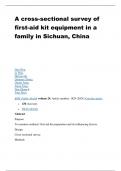A cross-sectional survey of
first-aid kit equipment in a
family in Sichuan, China
Dan Wen,
Li Wan,
Haiyan He,
Qianmei Zhong,
Qingli Jiang,
Xiuru Yang,
Dan Zhang &
Yuqi Shen
BMC Public Health volume 24, Article number: 1829 (2024) Cite this article
• 434 Accesses
• Metricsdetails
Abstract
Purpose
To examine residents’ first-aid kit preparation and its influencing factors.
Design
Cross-sectional survey.
Methods
,A questionnaire survey was conducted among 449 permanent residents in Sichuan
Province using convenience sampling. We examined participants’ demographic
characteristics, self-efficacy, health literacy, and personality.
Findings
Of the participants, 111 (24.7%) stocked a home first-aid kit. The most frequent
supplies were disinfection supplies (91.9%), common medicines (86.5%), and
dressing supplies (76.6%). Family per capita monthly income, medical expenses
payment method, chronic diseases, general self-efficacy, and health literacy were
influencing factors of family first-aid kit preparedness.
Conclusion
A multilevel and interactive emergency literacy education system should be
established to improve residents’ abilities to prevent emergencies.
Peer Review reports
Introduction
Globally, 45 million people are disabled and 5.8 million die each year due to
sudden trauma [1], the fourth leading cause of death. Injury-related death and
disability impose a massive burden on low- and middle-income countries,
comprising nearly 90% of the global injury toll [2]. The home first-aid kit is a
comprehensive first-aid kit for accidents, such as knife wounds or earthquakes.
They guarantee the safety of residents and play an important role when family
members are injured [3]. In recent years, living standards have improved, and
health awareness has been promoted. Home first-aid kits have been receiving
increasing attention. In particular, owing to the impact of the COVID-19 pandemic,
people’s attention and demand for medical and protective products have increased
rapidly.
According to cognitive theory, self-efficacy is the strongest factor affecting public
emergency preparedness behavior and a successful sustainer of health promoting
behavior. A study [4] has found that individuals’ emergency preparedness
behaviors are related to emergency knowledge, attitude, and self-efficacy. Findings
from a study investigating the relationship between personality traits and hoarding
behaviors in patients with novel coronavirus pneumonia, has found that, in
emergency situations, agreeableness, neuroticism, and openness tend to lead to
emergency supplies hoarding [5]. Health literacy refers to the ability of individuals
, to obtain and understand basic health information and make correct decisions to
promote their health. There is a positive correlation between health literacy and
health behaviors, including preventive measures and emergency service utilization
[6].
American public health agencies work to help people respond to disasters and
emergencies. In 2003, the U.S. Federal Emergency Management Agency launched
a national emergency preparedness campaign to encourage the public to prepare
emergency supplies [7]. In Australia, approximately one-fifth of households have
mobile phones, first-aid kits, batteries, and other first-aid items [8]. Facing frequent
extreme weather events and natural disasters, in 2015, China established its
Ministry of Emergency Management, and issued the Emergency Management
Standards. These standards encouraged households to stock first-aid kits and masks
and aimed to improve the public’s awareness of disaster prevention and mitigation,
as well as their ability to rescue themselves and others [9].
According to cognitive theory, self-efficacy is a pivotal factor influencing public
emergency preparedness and health-promoting actions. However, the specific
determinants motivating or impeding families in Sichuan to prepare and utilize
first-aid kits remain unclear. This study aims to bridge the knowledge gap by
exploring the relationship between emergency preparedness behaviors, personality
traits, health literacy, and household first-aid kit preparedness/utilization in
Sichuan, China, thereby offering insights for optimizing family emergency
preparedness and first-aid kit utilization.
Materials and methods
Participants
Families with reading comprehension and expression skills who had lived in a city
in Sichuan Province, China, for more than six months within the previous 12
months were included in this study. Participants with mental disorders and those
who provided incomplete information were excluded. After receiving a detailed
explanation of the study, each participant provided verbal informed consent.
Questionnaire
The questionnaire comprised three parts. The first was the sociodemographic
characteristics of the research participants, including gender, age, education level,
per capita monthly income of the family, whether family members suffer from
chronic diseases, and how medical expenses are paid. The second part of our study




